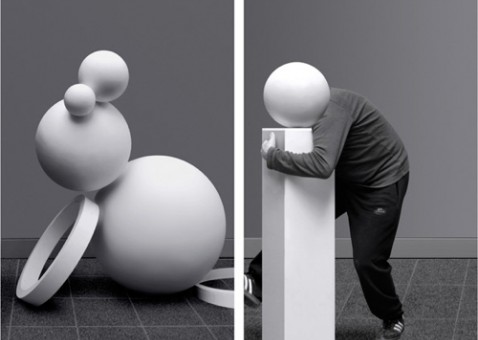wanderlust
What No Eye Has Seen…

“The Elementary Particles” is the title of Michel Houellebecq‘s highly controversial cult novel of 1998, whose screen adaptation by Oskar Roehler starring Moritz Bleibtreu was released in 2006. The novel’s narrator describes the two major metaphysical revolutions in the history of the world – the spread of Christianity and the beginning of materialism in the modern era, which signaled a breakdown of metaphysical values and a focus on the freedom of the individual. But according to Houellebecq, this freedom – symbolized by the Movement of 1968 – led to human suffering, which he ultimately tries to overcome in his novel. His vision is the creation of a new human being by means of biotechnology.
Transcendence in the post-metaphysical period
The subject of how transcendence manifests itself in this post-metaphysical period is also addressed by internationally renowned husband-and-wife artists Anna & Bernhard Blume at the Buchmann Gallery. “Aktionsmetaphern (Action Metaphors),” their final jointly realized show before Bernhard Blume’s unexpected death this past September, features twelve large-scale black-and-white photographs from the “Trans-Skulptur” series. As usual, the artists themselves are seen in these images – this time using oversized molecules as a backdrop. Anna Blume appears snorting as she floats in the air or yelling as she falls onto polyatomic particles; with great effort, Bernhard Blume carries the same particles around. How great to be able to have a good laugh during an art show again!
But what are we really laughing about?
Is this just a sign of goodwill toward the artists’ tongue-in-cheek attempt to control nature, despite our knowledge that we are powerless in the face of it? Or is it more a smile of pity because of our preposterous belief that we understand nature’s mysteries without actually doing so?
In the Blumes’ view, our laughter should make it clear how basically hybridized human existence is. And we should avoid believing that what we see is reality. Anything can be proved, if we want to, but what if it looked completely different?
Everything is not always as it seems
The Blumes’ photographs enable the viewer to expand his rationalistic perception of reality. Within this context, experiencing transcendence through art definitely seems like an appealing and contemporary phenomenon, possibly harking back to the insight that everything is not always as it seems. Or to close with the words of William Blake: “If the doors of perception were cleansed, every thing would appear to man as it is, infinite.”
- Anna & Bernhard Blume, “Aktionsmetaphern.” Buchmann Gallery, until January 12, 2012. Tuesdays – Saturdays, 11am – 6pm.
Be the first to write a comment.
Your feedback
